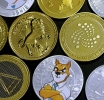Understanding the Basics of ERC-20 Token Standard

Understanding the Basics of ERC-20 Token Standard: A Comprehensive Guide
The ERC-20 token standard is a blueprint for creating fungible tokens within the Ethereum blockchain ecosystem. It stands for Ethereum Request for Comment and was introduced in November 2015.
The significance of ERC-20 lies in its contribution to the standardization of Ethereum tokens, ensuring that they all adhere to a specific set of rules.
This has greatly simplified the process of token integration by various entities such as wallets, exchanges, and other smart contracts.
The significance of ERC-20 lies in its contribution to the standardization of Ethereum tokens, ensuring that they all adhere to a specific set of rules.
This has greatly simplified the process of token integration by various entities such as wallets, exchanges, and other smart contracts.

Understanding the Basics of ERC-20 Token Standard
Understanding the Basics of ERC-20 Token Standard
Technical Specifications of ERC-20 Tokens
ERC-20 tokens are defined by a series of essential functions and properties that ensure their compatibility within the Ethereum ecosystem. These functions include totalSupply, which defines the total number of tokens available in circulation; balanceOf, which provides account balances; transfer, allowing token transfers between accounts; approve and transferFrom, which manage permissions for one account to spend another’s tokens; and events like Transfer and Approval, which provide logs accessible outside the blockchain.
The process of creating an ERC-20 token involves developing a smart contract that adheres to these standardized functions and properties. Deploying this contract onto the Ethereum blockchain requires programming knowledge, specifically in Solidity - Ethereum’s native language - as well as an understanding of smart contract development practices.
ERC-20 tokens are defined by a series of essential functions and properties that ensure their compatibility within the Ethereum ecosystem. These functions include totalSupply, which defines the total number of tokens available in circulation; balanceOf, which provides account balances; transfer, allowing token transfers between accounts; approve and transferFrom, which manage permissions for one account to spend another’s tokens; and events like Transfer and Approval, which provide logs accessible outside the blockchain.
The process of creating an ERC-20 token involves developing a smart contract that adheres to these standardized functions and properties. Deploying this contract onto the Ethereum blockchain requires programming knowledge, specifically in Solidity - Ethereum’s native language - as well as an understanding of smart contract development practices.
Advantages and Limitations of Using ERC-20 Tokens
ERC-20 tokens offer several benefits including interoperability, where different applications can easily interact with any token based on this standard. This creates efficiency and streamlines transactions across various platforms without needing separate systems for each new token type.
However, limitations do exist with challenges such as network scalability issues, leading to high gas fees during peak transaction periods. Smart contract vulnerabilities are also a concern since flawed code could be exploited if not carefully audited.
ERC-20 tokens offer several benefits including interoperability, where different applications can easily interact with any token based on this standard. This creates efficiency and streamlines transactions across various platforms without needing separate systems for each new token type.
However, limitations do exist with challenges such as network scalability issues, leading to high gas fees during peak transaction periods. Smart contract vulnerabilities are also a concern since flawed code could be exploited if not carefully audited.
Use Cases and Applications for ERC-20 Tokens
A multitude of projects leverage the versatility offered by the ERC-20 standard. For - example:
- Initial Coin Offerings (ICOs): Many startups have used ICOs facilitated through ERC-20 tokens to crowdsource capital directly from investors.
- Governance Tokens: Some decentralized organizations issue governance tokens based on this standard allowing stakeholders voting rights.
- Utility Tokens: Platforms create utility tokens serving various functions such as granting access to services or redeeming rewards.
Each use case demonstrates how foundational ERC-20 has been within cryptocurrency innovation spheres.
The Future Evolution of Token Standards Beyond ERC-20
Although impactful, developers have recognized areas where improvements are necessary leading to emerging standards like:
ERC-721: A standard for Non-Fungible Tokens (NFTs), representing unique assets different from one another.
ERC1155: A multi-token standard allowing both fungible (similar) and non-fungible (unique) assets under a single contract.
These new standards build upon or aim at refining what began with the first widespread token protocol: The venerable yet still highly relevant ERС‑20.Token standards will likely continue evolving alongside needs dictated by expanding crypto markets ensuring robustness in asset representation on blockchain platforms.
erc-20 # ethereum # blockchain # cryptocurrency # smart-contracts
A multitude of projects leverage the versatility offered by the ERC-20 standard. For - example:
- Initial Coin Offerings (ICOs): Many startups have used ICOs facilitated through ERC-20 tokens to crowdsource capital directly from investors.
- Governance Tokens: Some decentralized organizations issue governance tokens based on this standard allowing stakeholders voting rights.
- Utility Tokens: Platforms create utility tokens serving various functions such as granting access to services or redeeming rewards.
Each use case demonstrates how foundational ERC-20 has been within cryptocurrency innovation spheres.
The Future Evolution of Token Standards Beyond ERC-20
Although impactful, developers have recognized areas where improvements are necessary leading to emerging standards like:
ERC-721: A standard for Non-Fungible Tokens (NFTs), representing unique assets different from one another.
ERC1155: A multi-token standard allowing both fungible (similar) and non-fungible (unique) assets under a single contract.
These new standards build upon or aim at refining what began with the first widespread token protocol: The venerable yet still highly relevant ERС‑20.Token standards will likely continue evolving alongside needs dictated by expanding crypto markets ensuring robustness in asset representation on blockchain platforms.
erc-20 # ethereum # blockchain # cryptocurrency # smart-contracts














Report
My comments